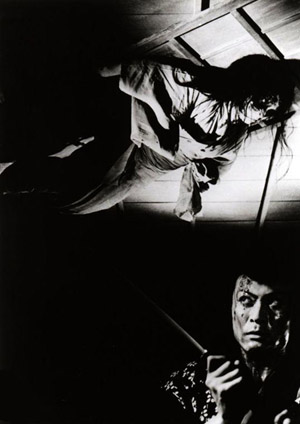From today through March 10, the Globus Film Series at New York’s Japan Society presents Into the Shintoho Mind Warp: Girls, Guns & Ghosts From the Golden Age of Japanese Film, “a retrospective of rarely shown films produced from the late 1950s to the early 1960s by mercurial, pioneering Japanese film studio Shintoho. Founded in 1947 by employees of the Tokyo-based Toho Company during strike action (its name means ‘New Toho’), Shintoho promptly established itself as one of the major studios of the second golden age of Japanese cinema, specializing in low- (or no-) budget productions that have become absolute cult classics.”
Writing for Artforum, Nick Pinkerton notes that the eight-film series curated by Mark Schilling, “an intrepid explorer of Japanese pop cinema,” will be traveling on Philadelphia’s International House, San Francisco’s Yerba Buena Center for the Arts, and Vancouver’s Pacific Cinematheque. “Schilling’s program is made exclusively of Shintoho works produced under the reign of Mitsugu Okura, a former silent film benshi storyteller and carnival worker who took over the cash-strapped studio in the mid-’50s and remade it in his own sensationalist, ‘Step right up!’ image. The series kicks off with Ghost Story of Yotsuya (1959) by Nobuo Nakagawa, who, in a nine-film cycle of kaidan-geki (ghost story) films for Shintoho, established himself as the genre’s ace.”
Peter Gutierrez at Twitch:
No joke: I’ve wanted to see Ghost Story of Yotsura for more than a quarter century—so you can imagine the level of my expectations… and the significance of my saying that Nobuo Nakagawa’s 1959 film exceeded them. Made shortly before his masterwork Jigoku, Yotsura is a film wherein you can feel Nakagawa’s brand of intoxicating horror in tension with the classical source material, and the end result is high art. The fact that nothing supernatural occurs for the first 50 minutes should provide a sense of the smart, stately build-up to the terror sequences. In terms of cinema, the aesthetic thrills are near-constant, and include the pendulum-swing of the frame in parallel to a key character knocking back some poison and, later, a phenomenal upwards tilt to follow the shocked gaze of our villainous protagonist. Meanwhile, horror fans should delight in the viciousness of the ghosts: even those not familiar with traditional kaidan but know its modern equivalent, J-horror, expect vengeful wraiths to mess with those who wronged them–but here they don’t care if total innocents are slaughtered in the process. Unforgettable in just about every aspect.
The video magazine The Seventh Art introduces its 11th issue, opening with interviews with filmmakers “who made two of the best films of last year (corroborated by Cinema Scope‘s top ten list) and who were equally charming, insightful and funny when we talked with them at the Toronto International Film Festival. Argentine director Matías Piñeiro presented his outstanding Shakespeare adaptation, Viola, and candidly discussed each of his films. Portuguese directors João Pedro Rodrigues & João Rui Guerra Da Mata brought their latest collaboration, The Last Time I Saw Macao, which is a pinnacle in their already strong body of work together that we were tremendously lucky to be able to discuss.” There’s also a profile of Pinewood Toronto Studios and a video essay on Nagisa Oshima‘s The Man Who Left His Will on Film (1970).
In the Voice, Stephanie Zacharek talks with Jeanine Basinger about “her perceptive and nimble book I Do and I Don’t: A History of Marriage in the Movies…. Her prose is fluid and adamantly unacademic, whether she’s outlining and analyzing the plot details of a Depression-era picture about the pratfalls of hasty marriage—the way, for example, James Stewart and Carole Lombard stumble toward potential happiness in the 1939 Made for Each Other—or launching into a dazzling riff on the rambunctious yet delicately calibrated partnership of Lucille Ball and Desi Arnaz on I Love Lucy. (That show isn’t, of course, a marriage movie, but it exploded previous notions of how marriage—and pregnancy—could be portrayed onscreen).”
In the works. “Think of the most overexposed figures in creative culture.” At Hyperallergic, Kyle Chayka gives us a couple of hints: “One stared at people for months straight in a major museum, had an opera made about her life, and is creating a museum-like institution devoted to her chosen medium. The other has turned his life into performance art, dabbled as a sculptor, and written a vanity short story collection, alongside a stint working on a soap opera.” To cut to the chase, Marina Abramović is planning to make a movie about James Franco.
“Ethan and Joel Coen are teaming up with Angelina Jolie to tell the story of World War II hero Lou Zamperini.” Borys Kit for the Hollywood Reporter: “The Coen brothers have been tapped to rewrite Unbroken, the adaptation of Laura Hillenbrand‘s 2010 book, for Universal—which has been trying to mount a Zamperini story in some form or fashion for decades.”
For news and tips throughout the day every day, follow @KeyframeDaily on Twitter and/or the RSS feed. Get Keyframe Daily in your inbox by signing in at fandor.com/daily.




